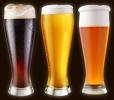
Good afternoon everyone!
Before we jump into today's lesson I just want to give everyone a reminder that our pilot episode is online at www.beerquest.tv, our official website! If you haven't already, please take a look and let us know what you think.
It’s been a little while since the last Beerducation segment and I hope you’re all ready to jump back into it. Today we will be talking about the ingredient which comprises the majority of the delicious beers you drink – water! Like Earth, your body and a two year old’s diaper, water reigns supreme. I’m sure many of you are thinking “How complicated can water be?” or “Are there gremlins living in my walls trying to sabotage my life?” I can’t help with the latter inquiry but I hope to shed a little light on the former.
Nowadays there are countless ways to tinker with our water with filtration, pH levels, and more. Back in the days of yore however people’s knowledge of water chemistry was simple in terms of being non-existent (coincidentally beer was often drunk as a safe substitute for what was often contaminated water). You must keep in mind too that water can be very different depending on its source. For example, certain sources had water with either high or low mineral contents which can have a profound difference on the beer.
What happened with these water sources was that certain cities, such as Pilsn, Dublin, Burton-on-Trent and more, became brewing centers which pioneered a number of beer styles based on the water sources that were available.
To use a classic example, Pilsn, a medieval Bohemian town, has very soft water meaning that it had fewer minerals. The effect on brewing was that it allowed for extremely crisp, clear beer with a sharp noble hop bite to it – the Pilsner. The Czech brewers also had to use special processes when steeping their grain as well to bring down their pH levels for proper mashing.
If you recall from a previous installment, mashing is when you steep the grain to create wort, the liquid base of beer. Mash pH should be roughly 5.4, give or take a little. To use another historical example in Dublin the alkalinity of the water balanced the acidity of darker malts, allowing the creating of dark beers such as stouts.
Water is by no means a simple beast and people continue to dissect its chemistry to learn all of its secrets. Most importantly though is that it has always been the cornerstone of life, and great beer all over the world, no matter what its profile may be. So next the time you have a tasty beer give a toast to this liquid helper and all of its refreshing goodness that makes the world go round.
